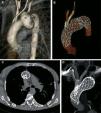A 62-year-old man with a history of hypertension, smoking, chronic obstructive pulmonary disease and coronary artery disease had a saccular aneurysm in the distal aortic arch (Figure 1A) involving the origin of the left subclavian artery (LSA), with a maximum diameter of 65 mm and a short proximal neck distancing 13 mm from the origin of the left common carotid artery (LCCA).
He was considered at high surgical risk and was referred for thoracic endovascular aortic repair with simultaneous preservation of perfusion of the innominate artery and LCCA through double-chimney technique.
The procedure was performed under general anesthesia. A Gore® TAG® stent graft was first inserted through the right common femoral artery and deployed at the distal end of the aneurysm, and a second one was inserted into the ascending aorta distally overlapping with the first. Two Gore® VIABAHN® stent grafts were introduced through the right axillary artery and LCCA and deployed at the proximal edge of the proximal TAG stent graft. Post-procedure computed tomography angiography (CTA) revealed a type II endoleak from the LSA, but follow-up CTA at one month revealed no endoleak and patency of the stent grafts (Figure 1B, C and D).
The double chimney is a recently introduced endovascular technique that provides an alternative to surgical treatment of aortic arch disease with preservation of the arch branches. There are a few case reports worldwide with acceptable short-term results, most associated with lower mortality and stroke rates compared to surgical or hybrid techniques. This case represents the first experience in Portugal with the double-chimney technique and long-term data are awaited.
Ethical disclosuresProtection of human and animal subjectsThe authors declare that no experiments were performed on humans or animals for this study.
Confidentiality of dataThe authors declare that they have followed the protocols of their work center on the publication of patient data and that all the patients included in the study received sufficient information and gave their written informed consent to participate in the study.
Right to privacy and informed consentThe authors have obtained the written informed consent of the patients or subjects mentioned in the article. The corresponding author is in possession of this document.
Conflicts of interestThe authors have no conflicts of interest to declare.






